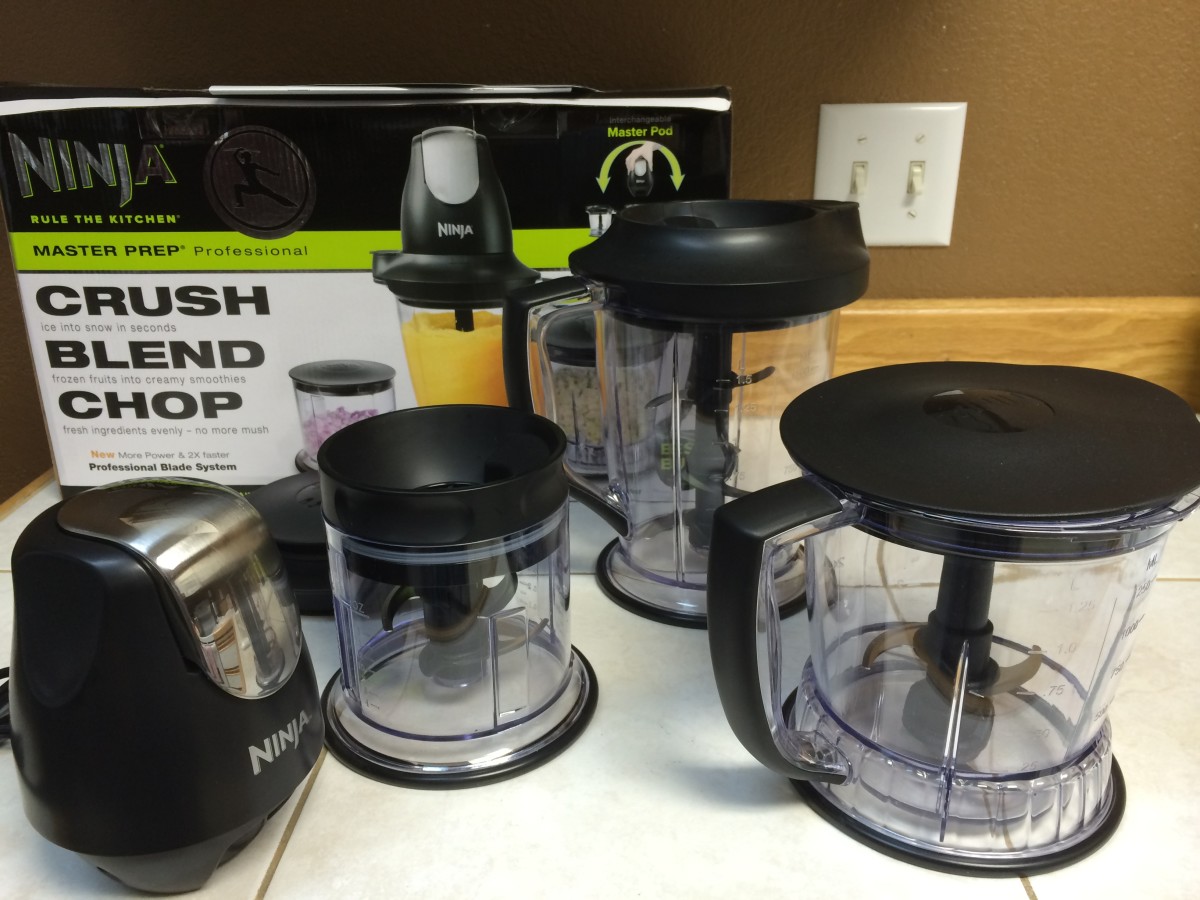Grinding Under the Millstone Wheat Flour
The other night I did something unusual. I put aside my usual "attitude in the kitchen" and stepped back in time to where we did everything in a labor intensive way. I baked the biscuits from scratch. I de-boned the chicken instead of buying the pieces already cut up, and made a mock version of one of my granddaughter's favorite fast food -- chicken nuggets. Just small things that women do everyday outside of my kitchen.
I'll be the first to admit that I'm no Suzy Homemaker wannabe, Betty Crocker clone, or June Cleaver act-alike. There are no Julia Child genes in my jeans, despite wonderful recipes handed down for generations. Yet, if you've read my other hubs, it's clear I can cook (if I want to). I can also make wine, can anything edible, forage, and bake. Just to be clear, I can -- I just usually choose not to.
Cooking is both an art and a science. The art part requires loving doing it. The science part requires attention to detail and measuring. The combination of them, requires hard work and involves cleaning up afterwards -- the part I am not fond of doing. Cooking is something I do because someone has to do it, or we'd all soon be dead from eating out every day and every meal. We'd also be broke.
What's more, cooking is often a thankless or take-for-granted job among the recipients of such meals. I'm not talking about my occasional culinary disasters. It's all about three adults in this house and one child -- each of us with very different ideas of what we will eat, what is good, and what is bad.
One member of the household has lips that won't touch vegetables. Another sitting at the table, will eat anything that doesn't eat them first, while being the most obnoxious food critic who has never cooked in their own life. Still another member of the receiving crowd, has very firm ideas that are clearly leading to vegetarianism.
Meal preparation is a challenge and a big bore in my cookbook of experiences. So, while I was "flouring" I amused my bored brain with memories -- memories of some of the old mill stones I've met along my adventures in life -- including those found inside of books.
A Bored Woman In the Kitchen Of Thankless Jobs
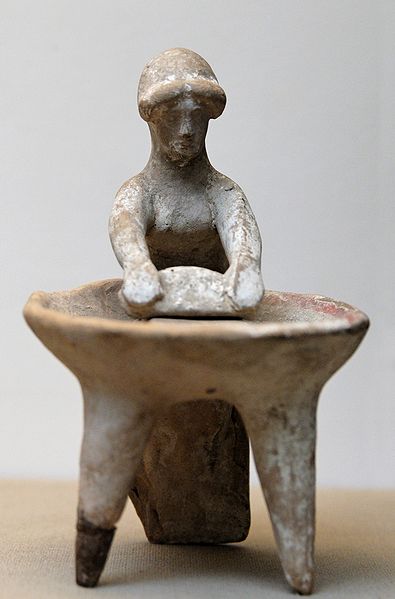
Now, I've seen flour mills of all kinds and varieties all around the globe. Notable were ones in Abruzzo, Italy and at Mayan ruins in Mexico. Down near the border of Mexico in a seldom mentioned Texas town, is the flour millstone of my deepest memory. It's not the first or the only old stone flouring mill that I've ever seen or visited -- it's just the one that had so much history surrounding it -- that it sleeps in my mind.
For those of you who have never given it much thought, in the earliest days, grinding mills consisted of two stones pounding or rubbing together, enough for the daily needs of the family.
The ancient miller was almost always a woman -- in times when a woman was regarded as little better than a slave.
Ever since wheat and other grains have been grown, and flour milled, bread became the necessity of human life. We call bread the "staff of life." Homer went a little further, he called it the "marrow of men."
Long ago, the discovery of the flour in wheat and barley -- perhaps by an accidental crushing -- led to the cultivation of many kinds of grains in every region where they can be grown. The use of mills of some sort for grinding the grain into flour went hand-in-hand with that cultivation of the grasses.
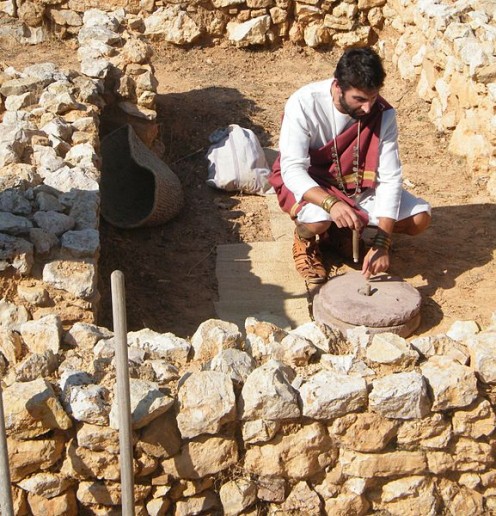
Wheat Flouring
Before the processes of milling can be understood, it is necessary to have a clear idea of the structure of a grain of wheat, because the difficulties in the processes are due to the presence in each grain of several very different elements.
A grain of wheat is a fruit -- I'm sure that will come as a surprise to many reading this. It is a store of nourishment on which the germ, which is only a tiny portion of the grain, may feed when it begins to grow.
The outer coat of the grain is the husk, coarse and tough. It is not used for human food. Inside the husk, likes the bran, which has several distinct layers and which, with its innermost layer -- the aleurone, makes up about a sixth of the whole grain.
This aleurone layer, rich in foodstuffs, surrounds the flour, or endosperm part of the grain. The problem of the miller is to secure this flour part in as great purity as possible. The germ is very small, amounting to hardly two per cent of the grain. However, it is rich in oils and has to be extracted from the flour if the flour is to keep well.

The First Flour Mills
The first flour mill was no doubt made of two stones. The grain was placed on the face of one, the nether(lower) mill stone, and broken or crushed by dropping the upper stone upon it -- that is pounding with the stone held in the hand.
Grinding or turning one stone on the other, took the place of pounding or crushing as time went on. An ancient Greek flour mill is dust described:
"Two round flat stones about two feet in diameter. The upper stone is turned by a handle inserted at one side, and has a hole in the middle into which the wheat is poured. By the process of grinding, the grain makes its way from the center and is poured out in the state of flour at the rim."
Many such milling stones existed around the world. Great examples in Ireland, the Orkneys, and Shetlands are to be found.
Some of the native tribes also made and still make flour by such methods. The Senecas tibe for example, boil corn and crush it into a paste between loose stones. The Omahas pound their cereal in a hole in the rocks, while the Oregon native peoples were known to pound and crush the capsule of the yellow lily to make flour.
Still other tribes in California made a sort of paste by crushing acorns between a round stone and a cup look hollow in the rocks.
With such primitive implements for making flour, milling was for many centuries a home grown and home made domestic industry. So important were household millstones to the health of families that the Hebrew law forbid anyone to take them for debt.
Whether the upper millstone was lifted and let fall, as in pounding -- or rolled, like a rolling pin, or pushed back and forth, or rotated about its center, on the nether millstone -- all of these methods were used in the development of "flouring." Not much progress could be made in this industry so long as it was worked by hand.
The Kinds of Mills
Women were employed as millers, both among the Greeks and the Hebrews, and probably among many other peoples -- but in quite ancient times we find men also put to this task.
Milling, even in the days of hand power, must have become partly a public enterprise, for prisoners as well as slaves were set to the task of grinding.
Samson, a captive of the Philistines, "did grind in the prison-home." Jeremiah pictures the final captivity of his people: "The took the young men to grind."
In one form of mill, the lower stone was shaped like a cup and the upper stone was rounded to fit the cup. In another, however, the lower was cone-shaped and the upper hollowed to fit over the cone.
In still another, both stones were flat and the grinding surfaces chiseled into grooves. The edges of the grooves did the grinding, while the meal worked its way along the grooves to the outer edge of the stone.
With a long arm, or "sweep" attached to the upper revolving stone, a large stone could be turned, either by man-power or by animal power. A donkey or a number of slaves would be attached to the sweep. Thus, the Roman emperors were able to establish public mills large enough to supply the poorer people of Rome with free flour.
Cave Dweller Making Flour Matmata, Tunisia
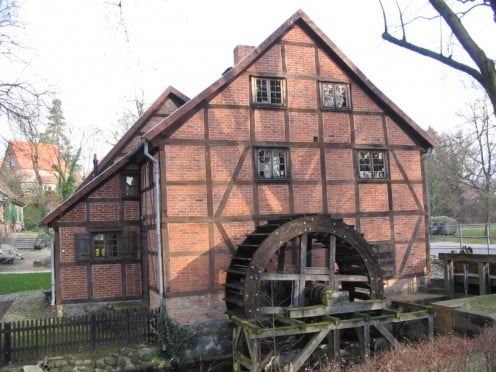
The Next Generation of Grinding Mills
One big advance was the discovery that a rapid stream or waterfall, if used to turn a wheel, would furnish much more power than can be applied either by hand or by animal power.
In the days of grinding by horse-power, ten horses were sometimes used on the sweep. It does not require a large waterfall to supply forty horse-power. So, with the water-driven flour mill a new era in milling began.
Soon the Romans used the swift current of the Tiber River to drive their mills. They also brought in water in aqueducts from the hills in the interior to run mills. This development began about 100 B.C.
In the Roman Empire, city-owned and state-owned mills soon came into operation, and millers' associations, or guilds were formed.
Strange as it may seem, there was no important improvement in the process of milling from the time of the Roman Empire till the eighteenth century. No new source of power was introduced except the windmill, and no new inventions were brought out to replace the upper and the nether millstones used by the Romans.
Grinding Grain in a Himalayan Villege
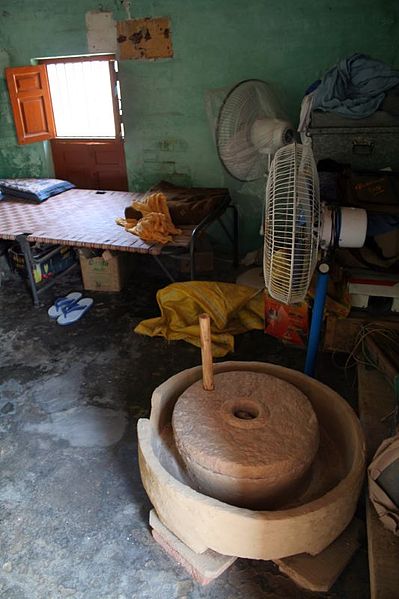
He Who Owns The Mill Owns His World
In the Middle Ages, scarcely a miller in Europe owned the mill he worked. The king, the feudal barons, the Church, and the municipal corporations, or towns, owned all the mills.
The millers who worked the mills were allowed for their work a certain percentage of the grain which they ground. The landlord took care in fixing the rent that the miller would retain for himself only a small quantity of grain.
There was thus, no reward for industry and no encouragement to improve the process of mill by new inventions. The miller of the Middle Ages was little better off than the slave who worked the mill in ancient time.
With the discovery and settlement of the New World, little changed. Whoever had a mill, often was the most important or richest person around. It also was common place for mills to be owned by towns, the church, and municipal corporations. Many settlers either had no mill available to them, or no money to buy flour -- and milling flour took a step back in time to when women had to grind their own flour if they wanted any.

Get The Biscuits While They Are Hot!
The biscuits are brown by now and the oven timer is being its usual obnoxious self. No, I didn't grind my own flour, Pillsbury did that for me, and this less than patient cook is eternally grateful for that.
There's more to the story of how flour is made, that came with the invention of the stem engine in the eighteenth century, and the genius of a man named James Watt -- alas that story is for another day, when a bored woman in the kitchen, has more time and less hungry mouths to feed.
If You'd Like to Know More!
Flour - Many Kinds and Colors
Say the word "flour" to most Americans and you'll have them immediately thinking of the bleached out white flour that they are familiar with.
However, there are many kinds of flour used the world around (most all of them are healthier) and here are a few:
- Acorn flour
- Amaranth flour
- Arrowroot flour
- Atta flour
- Barley flour
- Bean (or other legume) flours
- Bread flour
- Brown rice flour
- Buckwheat flour
- Cattail flour
- Chestnut flour
- Chickpea flour
- Chuno flour
- Corn flour
- Farro flour
- Flax flour
- Gluten flour
- Mesquite flour
- Millet flour
- Noodle flour
- Oat flour
- Peasemeal flour
- Peanut flour
- Potato flour
- Quinoa flour
- Rice flour
- Root flour (from many different kinds of plants)
- Rye flour
- Seed flour
- Semolina flour
- Soy flour
- Tapioca flour
- Taro flour
- Teff flour
- Vegetable flour
- Whole Wheat flour
Additionally, there a thousands of more types of flour to be made from plants around the world.


